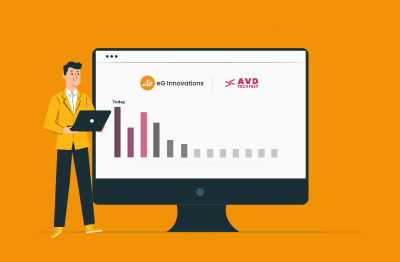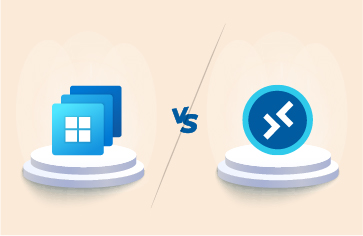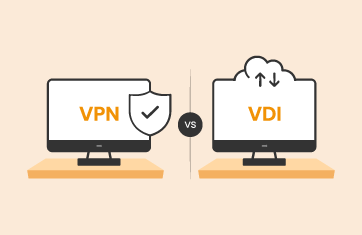Virtual Desktops on Microsoft Azure with AVD
Technology advancements have now made it possible for organizations to adopt virtual desktop technologies in a hassle-free manner, from the cloud using solutions such as AVD (Azure Virtual Desktop). Microsoft’s multi-session Windows desktop technologies supported on Azure cloud allow admins to provision virtual desktops on-demand. Integration with Azure Active Directory and FSLogix ensures secure access with efficient profile management.
Recently, there has been a lot of interest in AVD (Azure Virtual Desktop) technologies to support users working from home, to scale VDI capacity dynamically, and even as backup for VDI deployments on-prem.
“The report contains valuable insights, and a few surprises, but first and foremost an important perspective on the adoption of Azure Virtual Desktop. Partners should leverage these insights to implement appropriate services for the customer needs and customers should gauge their deployment and look for ways to improve operational efficiency, cost optimization and user experience.”
– Simon Binder, Co-Founder AVD TechFest
eG Innovations and AVD TechFest conducted a survey between February and March 2022 to shed light on several topics:
- Understand the state of virtual desktop technologies on Azure today
- Determine what technology choices organizations are making
- Where are organizations in terms of managing the performance of AVD deployments
- What are the areas where organizations deploying AVD need help
The resulting report is a compilation of the responses of 500+ IT professionals from across the world and includes learnings, analysis, and trends. This is intended to be useful for any IT professional working with digital workspace technologies such as AVD and VDI. You can download the full report which is full of useful statistics and facts on AVD uptake including the specifications of instances users are choosing, authentication choices (Azure AD vs on-premises AD) and FSLogix container usage. Some choice highlights are listed below.
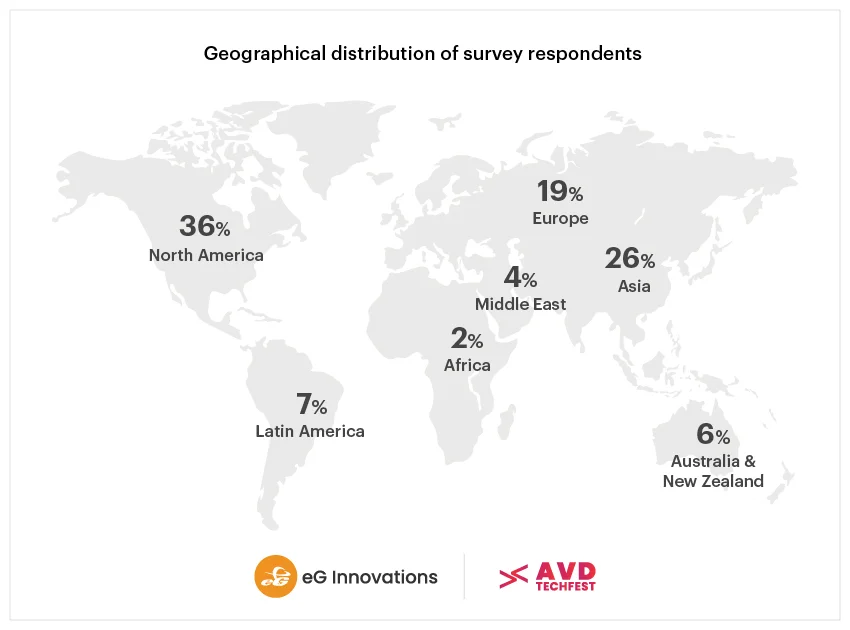
Interesting Findings about Azure Virtual Desktop Technology
1. The Uptake of Azure Virtual Desktop (AVD) Technology is Widespread and Fast
A relative newcomer in the VDI and digital workspace landscape, in the two years since its release in March 2021 it has rapidly gained traction. Our survey found that over 1/4 of respondents already have AVD deployed in production. Additionally, within 24 months, 58% of the organizations who responded intended to have AVD deployed. Only 5% felt that they did not see a need for AVD technology in their organizations.
Interestingly 80% of respondents do not see AVD as being their only digital workspace technology. The full survey investigated trends in AVD usage alongside other technologies such as Citrix CVAD/VMware on-premises and Cloud Citrix, VMware, and Amazon WorkSpaces alternatives.
More details including anticipated future usage and breakdowns by organization size are available in the full report.
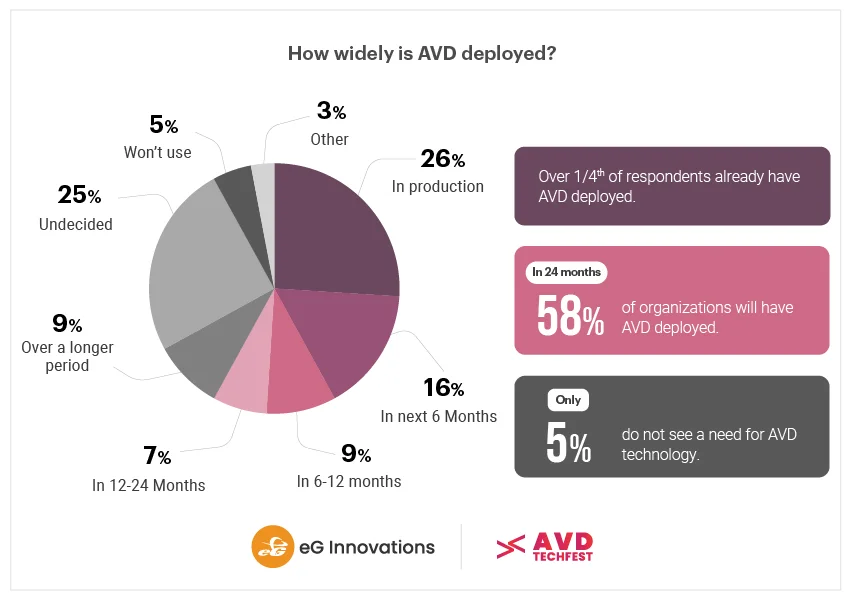
2. AVD is Reaching Customers Traditional VDI/Virtual Desktops Struggled to
The survey found that Azure Virtual Desktop deployments of all sizes were being undertaken. Overall, we are still early in the AVD adoption cycle. Close to 50% of deployments have less than 250 users.
73% of the AVD deployments have less than 1,000 users. In the medium-sized business market, AVD is competing against Citrix and VMware digital workspace offerings.
With 1/3 of deployments having less than 100 users, AVD is appealing and accessible to organizations that traditionally are considered too small to adopt on-premises Citrix/VMware VDI.
We do acknowledge that small deployments may also be larger organizations exploring AVD as an option for the future and it is a trend we will watch for when we next repeat the survey.
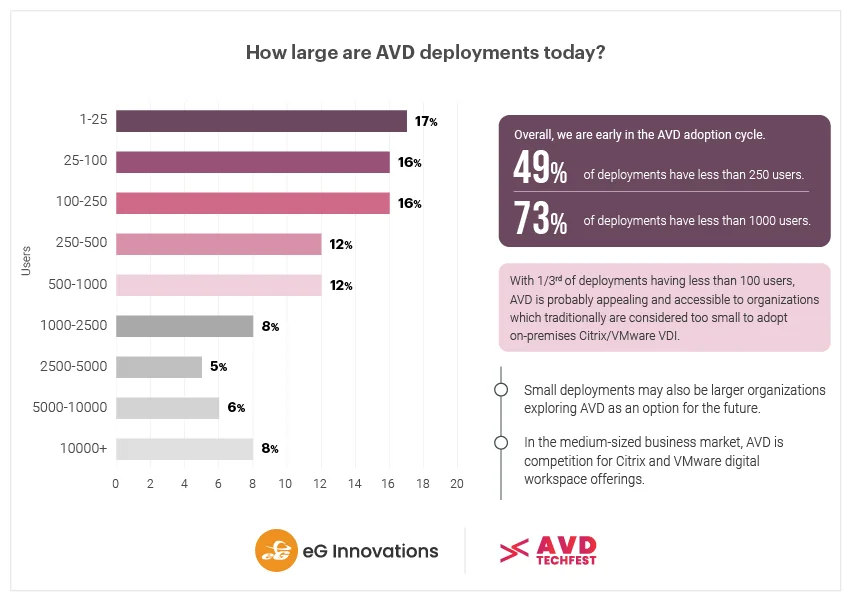
The full survey contains further details on the use of AVD broken down by use case including standalone AVD, and deployments involving Citrix and VMware used in conjunction with AVD.
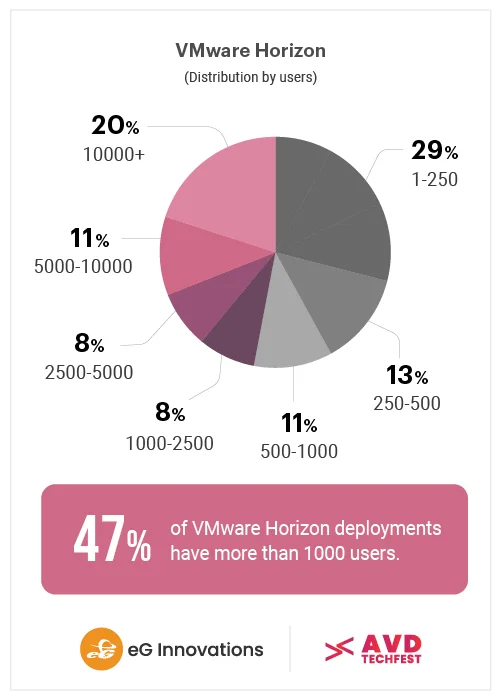
3. Maturity of Virtual Desktop Solutions being Implemented
The survey revealed a high level of maturity of solution and focus on user experience, with many best practices from VDI (Virtual Desktop Infrastructure) being applied. Whether you are building your AVD gold image via Image builder or configuring a virtual machine, optimizing the image, and installing any pre-requisites will make the experience much better for the end-users. The survey revealed that 76% were aware of these benefits and adopting image optimization. Details of the relative popularity of image optimization technologies including Microsoft Virtual Desktop Optimization Tool, VMware OSOT, Citrix Optimizer and BIS-F are contained in the full survey.
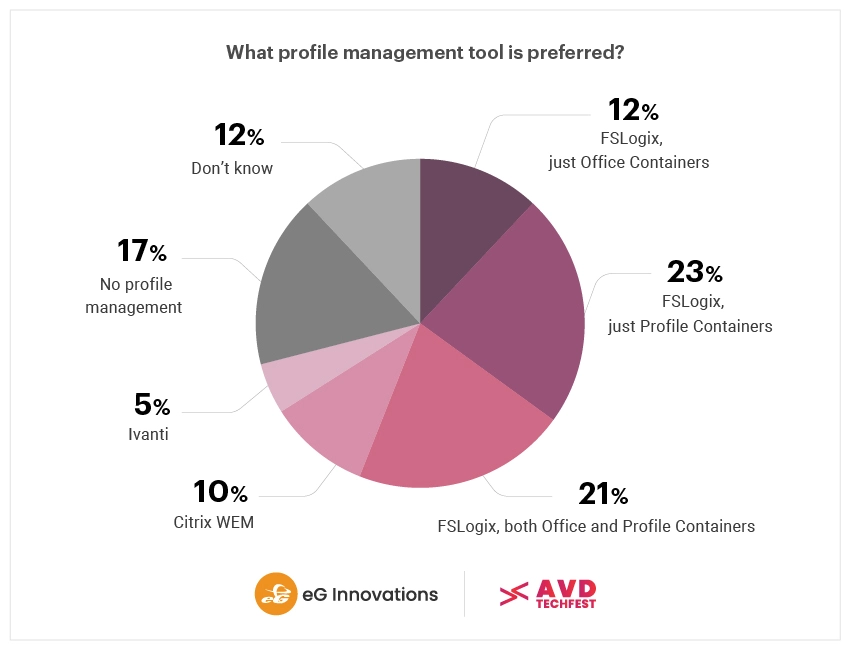
We also found that at least 71% are aware of and leveraging profile management. Again, indicating a maturity of solution and focus on user-experience. With FSLogix included with AVD subscriptions this was the most popular choice. The full survey also investigated the use of Office and Profile containers and the choice of both or just one type.
4. Premium Storage and GPUs (Graphics processing units) are becoming Mainstream for Virtual Desktops
The survey revealed that many users are adopting and investing in premium technologies that improve the user experience. 62% of organizations are using GPU technologies. This is remarkably high considering the small percent of overall Azure instance types with GPU support. We suspect that organizations have some VMs (Virtual Machines) that are GPU enabled, but not their entire deployment. NVIDIA GPUs were the most frequent choice, but we found significant uptake of AMDs offerings too. Premium storage solutions such as Azure NetApp files are gaining traction.
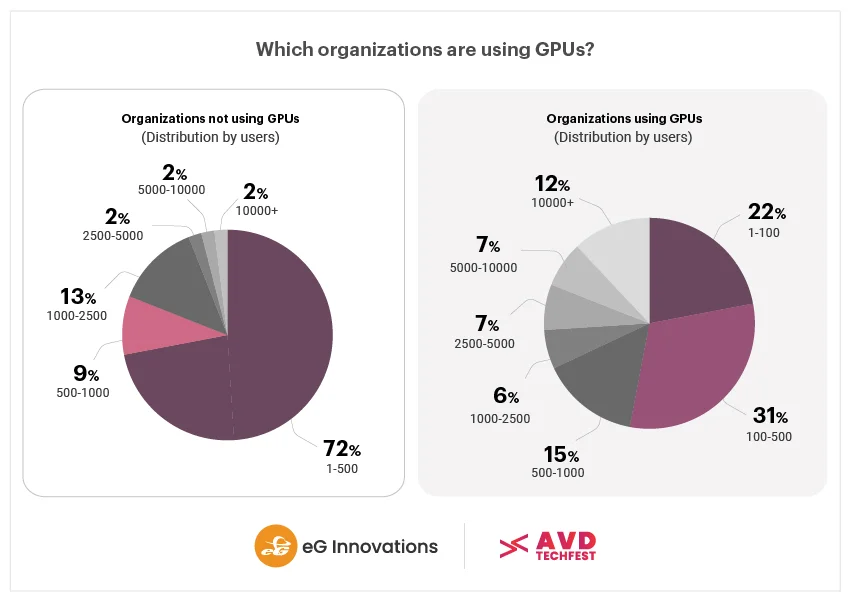
5. The Most Common Performance Issues and Failures in Azure Virtual Desktop Deployments
We surveyed the issues users are encountering with their real-world deployments.
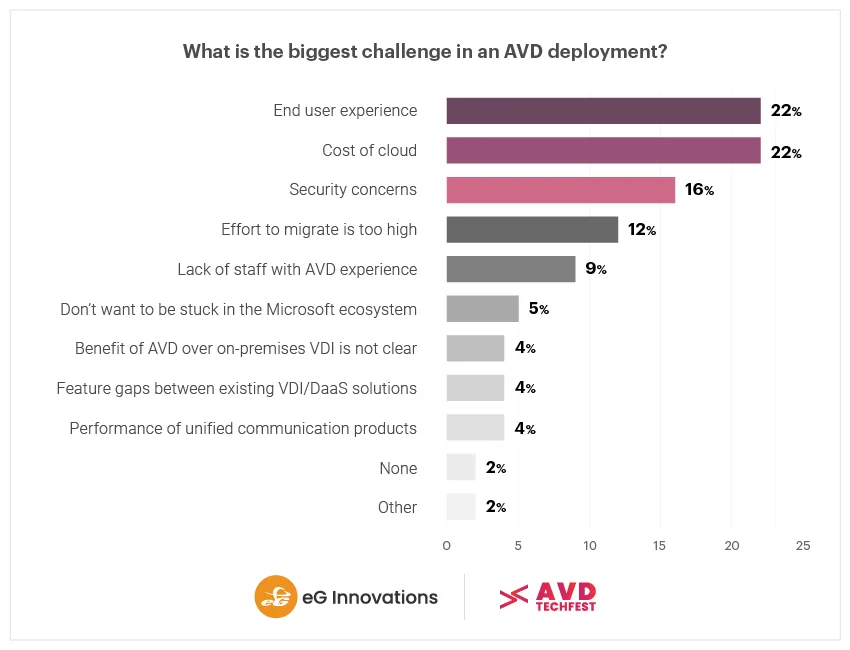
We also explored the most common issues and errors encountered in current deployments.
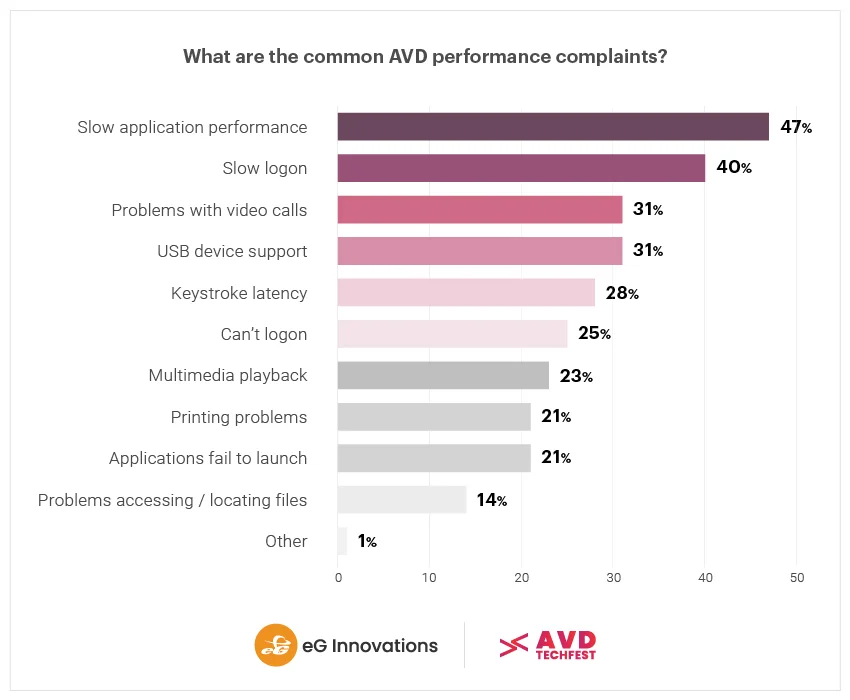
The number one performance issue that respondents face is slow application performance. 47% are struggling with “my application is slow” complaints. Slow logons and issues with video calls are the next two issues impacting user productivity.
As a number of these issues may not be caused by workspace issues themselves, end-to-end monitoring covering the entire service delivery chain is therefore seen to be particularly important.
6. Native Azure Virtual Desktop Monitoring Solutions have Problems
AVD is still a relatively recent technology and the native Azure Monitor solution using Log Analytics is still immature with complex pricing. Of those using Azure Monitor only 8% stated no pain points in our survey. The most common challenges and concerns were around costs – concerns about both the expense (30%) but also the uncertainty (30%) as to what those costs will be. Other reported issues included – Visualization limitations around dashboards, reports and ITSM ticketing integrations and the manual configuration and the lack of out-of-the-box features.
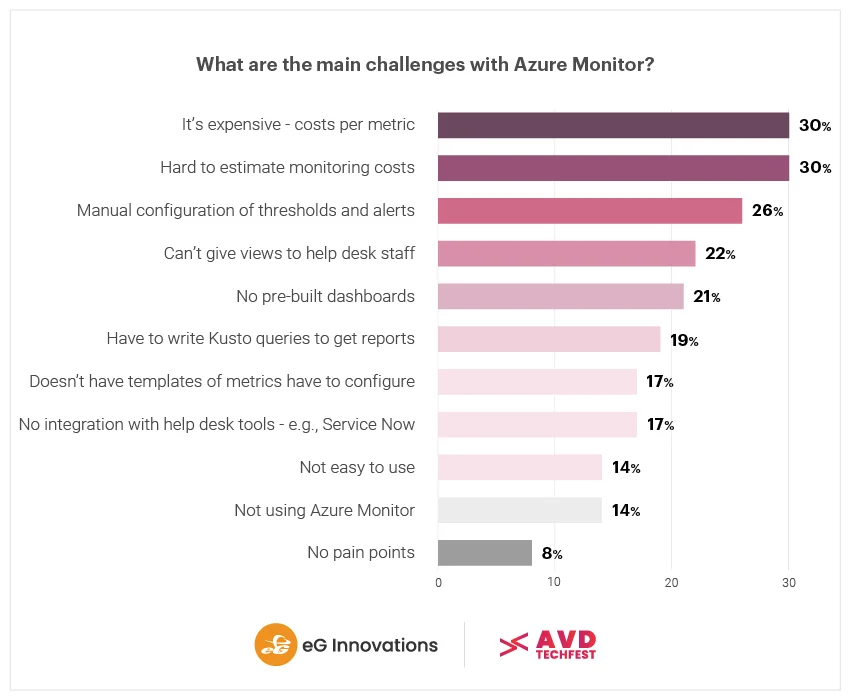
eG Enterprise is an Observability solution for Modern IT. Monitor digital workspaces,
web applications, SaaS services, cloud and containers from a single pane of glass.
Please See the Links below for Related Information:
- For information on attending the next AVD TechFest event in person or online – please see:
AVD TechFest 2022 – AVD TechFest 2021 – Live in Amsterdam - Azure AVD (Azure Virtual Desktops) Monitoring
- Azure Virtual Desktop Monitoring with Azure Monitor – Estimating Costs
- Azure Monitoring
- Azure AD Monitoring Tips & Strategies | eG Innovations
- Microsoft Monitoring: One-Stop Shop for Everything Microsoft
- Other technologies supported by eG Enterprise


